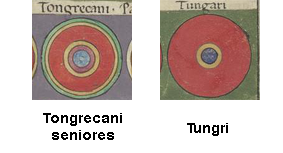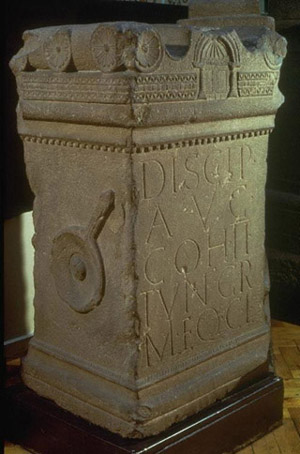
This page created 23 March 2014, and last modified: 8 November 2015 (commentary about British units greatly expanded)

The Tungri is listed (98/9.93 in Ingo Maier's numbering scheme) as the fourth-to-last of the units of auxilia palatina in the Magister Peditum's infantry roster; it is assigned (102/5.101) to the Comes Illyricum. Its shield pattern (95#8), under the matching label (95.h) Tungri, is shown in various manuscripts as below:

The shield pattern is very simple: an unadorned red main field, and a blue boss (white in B) encircled by a yellow band (white in M and possibly Ff). Although there is evidence that many labels attached to the shield patterns illustrating the western auxilia platina have been shifted from their proper places, it is not clear that this has happened to this unit; it may well be labelled with the correct shield pattern (see more below).
The unit's name derives from the Tungri, a people that lived in the Belgic region of Gaul, and which lives on in many modern names, most notably the city of Tongres/Tongeren. This contrasts with e.g. the palatine legionary unit the Tongrecani seniores (98/9.24), whose name seems to be derived via an intermediate source - the Roman district name of the Civitas Tungrorum. The Tungri (98/9.93), bearing a more clearly ethnic as opposed to geographical name, would presumably have been originally recruited from among the Tungri people before they were Romanised. But since the Tungri (98/9.93) is clearly a very late formation for a unit of auxilia palatina, probably nearly a hundred years older than the Tongrecani, this implies the unit was not a palatina unit when first named, and has a longer history.
Two units of auxiliary cohorts named Tungri were stationed in Britain from the start of the second century: the cohors I Tungrorum listed in the Notitia (154.24) as being stationed at Borcovicio (Vercovicium, modern Housesteads) under the Dux Britanniarum, and the cohors II Tungrorum, stationed at Cambloglanna (modern Castlesteads), and conjectured by Hassall (154.28.1) to have been deleted from the Notitia through a scribal error. Either of these two units could equate with the Tungri under the Comes Illyricum. It is notable that the previously-listed unit under the Comes Illyricum, the Seguntienses (102/5.100), is clearly an ex-British unit, its name indicating that it was formerly based at Seguntium (Caernarfon in Wales), which might well indicate that the next unit, the Tungri, given the Roman habit of brigading units in pairs, may also be British. That the only unit attested at Caernarfon (RIB 430), cohors I Sunicorum, just also happens to be a unit recruited from the the Belgic region of Gaul, just as the British-based cohortes I & II Tungrorum were, is unlikely to be a coincidence.
It would appear that portions of the British limitaneiunits were withdrawn from Britain to reinforce the continental armies. The Seguntienses have left no trace of their former station in Britain - indeed, no units are listed in Wales in the Notitia, and this has been seen as corroborating evidence from elsewhere that Magnus Maximus (reigned 383-388) withdrew all the regular units from Wales. Presumably withdrawals from the north of Britain happened in a more piecemeal fashion, and over a longer period of time: many British units seem to be re-listed as pseudocomitatenses units in the Magister Equitum's Gallic command, representing recent draftees. Others, such as the Tungri, have higher status, and thus have had time to be permanently incorporated into field armies such as that under the Comes Illyricu.
Which one of cohors I Tungrorum and cohors II Tungrorum is more likely to have become the Illyrian Tungri is hard to tell. Both Housesteads and Castlesteads seem to have been abandoned about the same time (among the forts along the wall, only Banna - modern Birdoswold - shows clear evidence of occupation well into the 5th century). Cohors II Tungrorum might make more sense if Hassal's lacuna is not in fact a lacuna, but a genuinely excised unit and location, due to the unit having been withdrawn from the frontier before its neighbours.
It is of some interest to note that the Tongrecani seniores has a similar shield pattern to that of the Tungri, albeit somewhat more decorated, as a comparison of the patterns shown below taken from the Paris manuscript show:

This apparent relationship increases my confidence that the Tungri has the correct shield pattern associated with its label. However, if these patterns are genuinely "related", and not just coinicdental, it raises the question of what the relationship between the two units was; for they would not have been brigaded together, one being legionary and the other auxiliary, and they were not raised at the same time. I would suggest that the Tungri were drafted initially into the Magister Peditum's Italian command after leaving Britain, and only later moved into the command of the Comes Illyricum, and they picked up a similar, albeit simpler, shield pattern to the similarly-named Tongrecani seniores that happened to be in the same command as a token of respect or similar for the senior unit.

An altar from Birrens (RIB 2092 = AE 1987, 60) dedicated by the men of the cohors II Tungrorum milliaria equitata in the second century, before the unit moved to Castlesteads, has a carving showing a patera (libation bowl) on the side, although the handle is somewhat unusual (see the picture above). However, its apparent "boss" makes me wonder if it is consciously echoing a circular shield, as such concentric rings are typical of many Notitia shield patterns, and of the Tungri's pattern in particular (many such vessels found in non-military situations also show such a boss, it must be said, which appears to have facilitated holding the vessel, but as this one also has a handle, such as functional element would seem to be unnecessary).
1. Ingo Maier; "Appendix 4: Numeration of the new edition of the compilation 'notitia dignitatum' (Cnd)"; last accessed 26 October 2015. See also for here for numbering examples. Return
2. M.W.C. Hassall; "Aspects of the Notitia Dignitatum", Oxford, 1976; at p 113. Return

Return to the Notitia alphabetical unit list page.
Return to my Notitia index page.